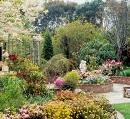
By: Tian Xiangyu
Word Count: 479
Flower gardening can allow you to express your creativity, to get closer to nature, and to further enjoy being human. Here we present a few special flower gardening tips to help you be a more effective and creative flower gardener.
Plant the best flowers for your space. It's important that you work with nature and not against it. Don't overwhelm a small space with a large number of plant species. Select just a few so your flower garden does not look cluttered. You should plant sun loving flowers in a sunny location, shade loving flowers in a shady location. By selecting plants that are well-suited to your growing zone, as well as the area of your flower garden, you'll have to do a lot less work and make your flower gardening much more rewarding. Space the plants to allow for their mature size.
Prepare for the soil. Producing gorgeous flowers requires good soil, so make sure your soil is healthy and rich. Good soil means good roots. Your flowering plants need healthy roots to support and nourish the stems, foliage and flowers. Loosen the soil down about six inches for annuals, ten to twelve inches for perennials. Mix in organic matter such as compost. Check the pH to see if you need to add lime or sulfur to adjust the pH.
Flower gardening requires the right tools. This means, not only, your trowels, shovels and hoes, but also fertilizer, soil amendments and watering aids. Having the right tools will make your flower gardening easier and more enjoyable.
It's important to prune flowers for continued growth. This pruning includes dead-heading and cutting flowers back for inside arrangements. To deadhead a plant, you need to simply snip the dead or dying bloom off the mother plant. By removing the flower head, you keep the plant from focusing its attention on the creation of seeds, which will form in the dead flower head.
Use best fertilizer for flowers. You can use a general purpose granular fertilizer or a slow release granular fertilizer with an analysis of 10-10-10 or similar. Read and follow the label directions for how much to use. Never use more than the amount on the label. Over-fertilized plants are more prone to pests and diseases; if in doubt, use less.
Water Flowers Correctly. Watering flowers according to their specific needs is essential to successful flower gardening. Most flowers prefer soil that is evenly moist yet well drained. When you do water, apply it slowly and thoroughly. To be effective, the water must soak down to the deepest roots. It's best to water early in the day to prevent evaporation and leaf-burn.
Follow the above tips to grow a healthy, beautiful flower garden overflowing with buds and blooms of all kinds all season long.
Leading eBooks Company
Article Source: http://www.ArticleBiz.com
© All Rights Reserved. - ritasonlineproducts


















